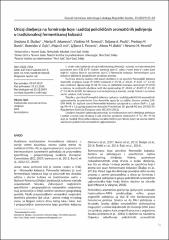| dc.description.abstract | The aim of this study was to determine the effects of traditional drying and smoking process
on colour characteristics and content of polycyclic aromatic hydrocarbons in Petrovská klobasá. This
sausage is dry fermented sausage with protected designation of origin according to Serbian legislation.
Instrumental colour characteristics (CIE L*a*b* system: lightness-L*; redness-a*; yellowness-b*; hue
angle-h and chroma-C*) are determined on the surface of Petrovská klobasá at 0 day of production,
at the end of the drying period (60th day of production) and at the end of storage period (270th day
of production). Colour measurements were performed using the Minolta Chroma Meter CR-400.
Petrovská klobasá had significantly lower (P<0.05) values of colour characteristics L*-25.59, a*-10.31,
b*-8.20 and C*-13.18, but differences were not significant (P>0.05) for hue angles value (h-38.76) at
the end of the drying period compared to those at zero day of production (L*-43.63; a*-23.07; b*-
21.42; C*-31.48 and h-42.85). During the storage period there was no change in the surface colour,
because instrumental colour parameters were not significantly different (P>0.05) at the end of the
storage period (L*-23.88; a*-7.08 and b*-6.53; h-43.93 and C*-9.66) compared to the values of the
colour characteristics determined at the end of the drying period.
Also, in the samples of Petrovská klobasá the contents of polycyclic aromatic hydrocarbons
(acenaphthylene, fluorene, phenanthrene, anthracene, pyrene, benz[a]anthracene chrysene, benzo[b]
fluoranthene, benzo[k]flouranthene, benzo[a]pyrene, indeno[1,2,3-cd]pyrene, dibenz [a,h]anthracene
and benzo[ghi] perylene) from Environmental Protection Agency list (13 US-EPA) were determined.
PAH analyses were performed on gas chromatograph coupled with mass spectrometer. All examined
samples of sausages met the criteria (BaP ≤ 2 μg/kg; PAH4 ≤ 12 μg/kg) prescribed by Serbian legislation
(Official Gazette of the SCG, No 29/2014) and Regulations Commission of the European Union (EC
835/2011).
The results obtained in this work confirmed that the traditional smoking process, which was
defined in this study (8 days; 6 hours per day; average values of t~9 °C and RV~79 %), provided
Petrovská klobasá with characteristic colour properties and very low content of polycyclic aromatic
hydrocarbons. | en_US |

